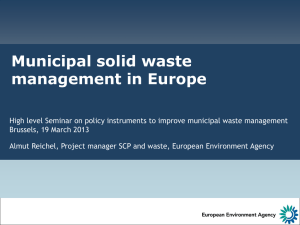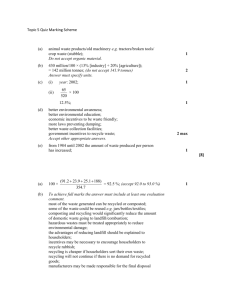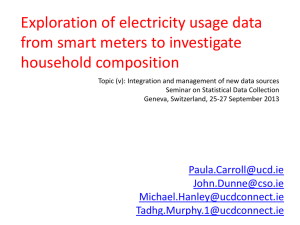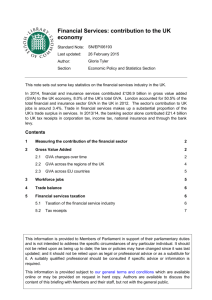WST 001 waste generation_fact sheet_for Eionet review
advertisement
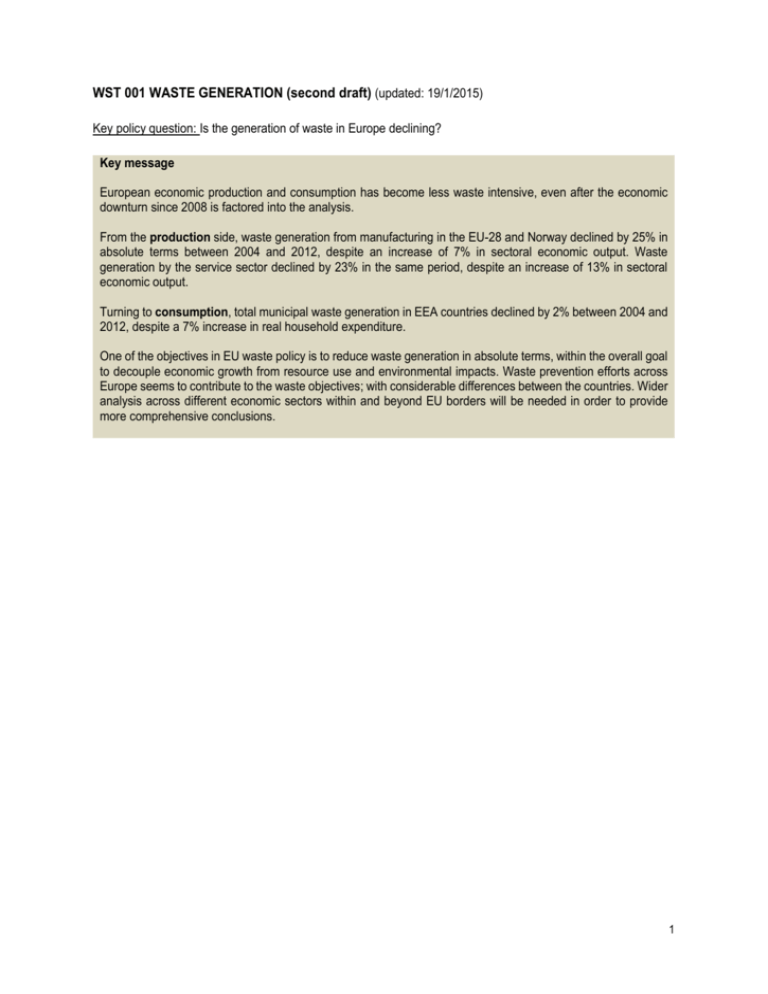
WST 001 WASTE GENERATION (second draft) (updated: 19/1/2015) Key policy question: Is the generation of waste in Europe declining? Key message European economic production and consumption has become less waste intensive, even after the economic downturn since 2008 is factored into the analysis. From the production side, waste generation from manufacturing in the EU-28 and Norway declined by 25% in absolute terms between 2004 and 2012, despite an increase of 7% in sectoral economic output. Waste generation by the service sector declined by 23% in the same period, despite an increase of 13% in sectoral economic output. Turning to consumption, total municipal waste generation in EEA countries declined by 2% between 2004 and 2012, despite a 7% increase in real household expenditure. One of the objectives in EU waste policy is to reduce waste generation in absolute terms, within the overall goal to decouple economic growth from resource use and environmental impacts. Waste prevention efforts across Europe seems to contribute to the waste objectives; with considerable differences between the countries. Wider analysis across different economic sectors within and beyond EU borders will be needed in order to provide more comprehensive conclusions. 1 Figure 1 Waste generation by production and consumption activities in the European countries, index (2004=100) 115 110 105 Index (2004=100) 100 95 90 85 80 75 2004 2005 2006 2007 2008 2009 2010 2011 2012 Waste generation in manufacturing (tonnes) (EU28+NO) GVA in manufacturing (EUR) (EU28+NO) Waste generation in services (tonnes) (EU28+NO) GVA in services (EUR) (EU28+NO) Municipal waste generation (tonnes) (EEA33) Household expenditure (EUR) (EEA33) * Gross Value Added (GVA) is the value of output less the value of intermediate consumption. It is a measure of the contribution to GDP made by an individual producer, industry or sector, as defined by the OECD’s Glossary of Statistical Terms. Note: The data for manufacturing and services sectors’ waste generation and GVA cover the EU-28 and Norway. Manufacturing and services data are missing for Croatia for 2006. As the data on waste generation in manufacturing and services are reported biennial, data gap filling was applied for the years 2005, 2007 and 2009 (by calculating mean values). The municipal waste and household expenditure data cover all EEA-33 countries except Liechtenstein. Data for household expenditure for Turkey is missing for 2011 and 2012. For these two years data for 2010 was used. Data sources: 2 'Generation of waste (env_wasgen)’ in tonnes: http://appsso.eurostat.ec.europa.eu/nui/show.do?dataset=env_wasgen&lang=en ‘Municipal waste (env_wasmun): http://appsso.eurostat.ec.europa.eu/nui/show.do?dataset=env_wasmun 'National Accounts by 10 branches - volumes (nama_nace10_k)’ in millions of euro, chain-linked volumes, reference year 2000 (at 2000 exchange rates): http://appsso.eurostat.ec.europa.eu/nui/show.do?dataset=nama_nace10_k&lang=e' 'GDP and main components - volumes (nama_gdp_k)' in millions of euro, chain-linked volumes, reference year 2000 (at 2000 exchange rates): http://appsso.eurostat.ec.europa.eu/nui/show.do?dataset=nama_gdp_k&lang=en KEY ASSESSMENT The waste hierarchy, the guiding framework in EU and national waste policies, gives the highest priority to waste prevention, followed by (preparing for) re-use, recycling, other recovery and disposal. The highest priority to waste prevention is also highlighted by the recent waste and resource efficiency policies and strategies at EU and national levels. Measuring waste prevention is a complex task. Quantifying waste prevention is difficult since it often amounts to measuring what is not there. For that reason, waste generation related to demographics or economic activity, as well as waste generation as such are considered the closest approximation for measuring quantitative waste prevention. European economic production and consumption is apparently becoming less waste intensive, even after the economic downturn since 2008 is factored into the analysis. European trend, however, masks differing developments across European countries. Production activities In EU-28 and Norway nearly half of the total waste, excluding major mineral wastes, was generated by the manufacturing and services sectors in 2012, while their contribution to the total GVA was predominant. For both sectors, generation of waste declined in spite of increased economic output over the period 20042012 (Figure 1). The most notable decline in waste generation was observed in the manufacturing sector with 25% expressed in absolute terms. In the same period its economic output increased by 7%, with the largest increase in the information and communication sector. In the same period, economic output from the services sector increased by 13%, while waste generation declined by 23%, expressed in absolute terms. It is considered that the services sector is less waste intensive than the manufacturing sector on average. As the waste intensity of the service sector (0.014 kg/EUR in 2012) was lower than for the manufacturing sector (0.12 kg/EUR in 2012), a shift to the services sector in the economy is a contributor to less waste generation. This improvement might be due to a combination of various factors: efficiency improvements in production processes and management, changes in the structure of the manufacturing sector, increase in activities in services sector and a shift towards less-intensive waste generating activities. According to the recent Environmental Indicator Report, EEA, 2014, the structure of production in Europe has changed in large part due to a shift of industrial production to regions of the world with lower labour costs in the past two decades. Trade liberalisation combined with lower labour costs and less regulation in many 3 developing countries can act as driving forces for a shift towards the production of goods consumed in Europe to other regions of the world. Some sectors, including the metals, telecommunications, electrical, textiles, food and chemical sectors have been particularly affected by relocations since 2000. This development might have added to the decline in waste generation. The share of services in the EU economy has increased, with the largest growth in the information and communication services sector. The Report also concludes that ’many environmental pressures within Europe are decreasing’, which is partially associated to the ’more eco-efficient production, but partially to the fact that resource extraction and the manufacturing of many intermediate goods and final consumer products have relocated elsewhere’. Consumption activities In EEA-33, excluding Liechtenstein, generation of municipal waste slightly declined by 2% between 2004 and 2012, despite an observed increase in household consumption expenditure of 7% in real terms (Figure 1). Generation of municipal waste was in continuous decline since 2007; showing absolute decoupling from household expenditure between 2009 and 2011. Behind the overall declining trend, there is large diversity between the EEA countries. Albeit temporary recovery of household consumption expenditure, generation of municipal waste continues to decline for more than 6% between 2007 and 2012. It would require much more detailed data to find out if waste prevention policies in the countries have contributed to the decline in waste generation. Some countries have achieved a stabilisation of waste generation or even a reduction, while others follow a constant increase. One of the objectives in EU waste policy is to reduce waste generation and to decouple waste generation from economic growth and environmental impact. Implementation of relevant EU policies in combination with improved waste prevention efforts across Europe seems to contribute to the waste objectives. Nevertheless, in-depth analysis across different economic sectors will be needed in order to provide more comprehensive understanding of the presented trends. Waste collection methods (e.g. change in national reporting method over time), might also have played a role when interpreting waste generation trends. Reporting systems need further harmonization in order to ensure the figures reported by countries are comparable. Data sources EEA data references (if data is taken from EEA sources) None External data references (e.g. Eurostat, European Commission) Justification for indicator selection The proposed core set indicators (WST 001 waste generation, WST 002 waste recycling and WST 003 diversion of waste from landfill) on waste address relevant policy questions, referring to objectives and targets of the 2008 EU Waste Framework Directive and other relevant directives, the 2011 Roadmap on a Resource Efficient Europe and the 7th Environment Action Programme (EAP). These policy questions can be expected to be relevant also in the coming years at least until 2020. As such, the proposed indicators reflect on the elements of the waste hierarchy, in particular on waste prevention, waste recycling and waste diversion from landfill. 4 Decoupling economic growth from the environmental impacts associated with the generation of waste is a waste prevention objective of the EU’s Waste Framework Directive. Waste generation – in absolute terms and compared to economic activity – is considered as the closest approximation to measure quantitative waste prevention. Waste prevention is strongly linked with economic development, but also production and consumption structures. Waste prevention can be achieved by reducing the quantity of material/resources used in manufacturing of products and services and by increasing efficiency of manufacturing process and products used (quantitative prevention) and by reducing their hazardous contents (qualitative prevention). However, only quantitative waste prevention is covered by this indicator. Preventing waste by changing consumption patterns and by designing and consuming products that generate less waste are forms of strict avoidance of waste. In order to capture these two aspects, the indicator shows both waste generation in a production perspective and in a consumption perspective. Scientific references (for the indicator justification, if available) None 5 INDICATORS SPECIFICATIONS Indicator definition This indicator shows the generation of waste in two different phases: during the production phase, and during the consumption phase. The production phase shows the generation of waste in absolute terms from manufacturing and services sectors (excluding major mineral waste) and their economic output expressed as GVA. The consumption phase shows the generation of municipal solid waste (further in the text referred as municipal waste) and corresponding household consumption expenditure. Units Production phase: Indexed values of GVA in manufacturing and services sectors (in EUR) and waste volumes from two sectors (in tonnes) (2004=100). Consumption phase: Indexed values of household expenditure (in EUR) and municipal waste volumes (in tonnes) Policy Context and targets Context description Europe’s approach to the waste management has experienced gradual transition towards treating waste as an important resource. The waste management has been moving up in the waste hierarchy, with less waste landfilled, as a result of reduced waste generation and increased recycling and recovery efforts. Long-term waste policies have been successful so far, but there is still a large potential ‘in moving towards circular economy where ultimately nothing is wasted’. Although importance of waste prevention has been recognised in European waste legislation since its first 1975 Waste Framework Directive (75/442/EEC), effective waste prevention measures in the Member States have been lacking. Was prevention was, however, highly visible in 2005 Thematic Strategy on the prevention and recycling of waste (COM/2005/0666) and further underlined in the Waste Framework Directive (2008/98/EC). Article IV of the Directive set that waste prevention measures should be considered a top priority when developing waste policy and legislation in the EU and its Member States to adopt and implement waste prevention programmes. Policies on the waste prevention still have to prove their effectiveness. According to the Waste Framework Directive, all EU member states had to adopt Waste Prevention Programmes by the end of 2013. A first review of available programmes indicates that countries plan to use a broad range of measures with a focus on information-based instruments. However, only very few programmes include quantified waste prevention targets or economic instruments (EEA, 2014). Waste prevention and using waste as a resource is becoming more and more important, not only in environmental policies, but also in industrial and raw material policies, and as a backbone of the transitions towards a green economy. In 2011, the Roadmap to a Resource Efficient Europe (COM(2011)571) sets the ambition that waste generation per person should be in absolute decline by 2020. Two years later, the EU’s 7th Environment Action Programme recognises the need for additional efforts to reduce waste generation both per person and in absolute terms. 6 Targets No quantitative waste prevention targets are established. Related policy documents - - - EC, 2005, Communication from the Commission to the Council, the European Parliament, the European Economic and Social Committee and The Committee of the Regions — Taking sustainable use of resources forward — A Thematic Strategy on the prevention and recycling of waste, COM/2005/0666 final. EC, 2011, Communication from the Commission to the European Parliament, the Council, the European Economic and Social Committee and the Committee of the Regions 'Roadmap to a Resource Efficient Europe', COM(2011) 571 final. EEC, 1975, Council directive 75/442/EEC of 15 July 1975 on waste (OJ L 194, 25.7.1975, p.39-41), 75/442/EEC. EU, 2008, Directive 2008/98/EC of the European Parliament and of the Council of 19 November 2008 on waste and repealing certain Directives, OJ L 312, 22.11.2008, pp. 3–30. EU, 2013, Decision No 1386/2013/EU of the European Parliament and of the Council of 20 November 2013 on a General Union Environment Action Programme: to 2020 Living well, within the limits of our planet, OJ L 354, 20.12.2013, pp. 171–200. Methodology Methodology for indicator calculation Raw data for waste generation (manufacturing, services and municipal) and economic parameters (GVA, household consumption expenditure) was retrieved from Eurostat. Data is aggregated into the widest possible geographical coverage; for production phase – manufacturing and services waste generation and GVA calculations cover EU-28 and Norway; for consumption phase – municipal waste generation and household consumption expenditure cover all EEA countries, except Liechtenstein. The aggregated figures are indexed to 2004, which means that the figure for each year is divided by the figure for 2004 and then multiplied by 100. Notes on missing data: Production phase: The raw data of waste amounts for manufacturing and services sectors in tonnes and of GVA in million EUR are indexed for the year 2004. Countries have been excluded where no reporting took place for more than one year in the time series. Consumption phase: The raw data of municipal waste in thousand tonnes and household expenditure in million EUR are indexed for the year 2004. Methodology for gap filling (if any) Production phase: Manufacturing and services waste data are missing for Croatia for 2006. The value for this data point was interpolated with data for 2004 and 2008. Data for household expenditure for Turkey is missing for 2011 and 2012. For these two years data for 2010 was used. Consumption phase: No gap filling required. Methodology references 7 None Data specifications There are three different waste categories and two different GVA categories used for Figure 1. The waste categories are: 1) manufacturing waste, excluding major mineral waste, generated by the specific economic sectors of manufacturing (NACE Rev.2 category C), 2) services (NACE Rev.2 category G-U_X_G4677, excluding wholesale of waste and scrap), and municipal waste. The GVA categories are: 1) GVA for manufacturing sector, 2) GVA for services sector, 3) household consumption expenditure. EEA data references None Uncertainties Methodology uncertainty There is little uncertainty about the methodology used. More accurate comparison for consumption phase could be comparing household consumption expenditure with generation of household waste. Data sets uncertainty Data sets uncertainties can be found directly at the metadata and explanatory notes provided by Eurostat. Rationale uncertainty Waste generation can be used only as a proxy for measuring waste prevention. Further work Short term work The indicator might include two separate graphs on the production and consumption activities. All values might be expressed also in per capita values in order to monitor progress over the years (and compare it against the policy objectives). Long term work Other waste streams might be added to the indicator if and when better data becomes available, for example construction and demolition waste, or agriculture waste in case of production activities; and for consumption that might be household waste. Also, when data sets are completed for the countries currently not included in the analysis, country will be added. 8



